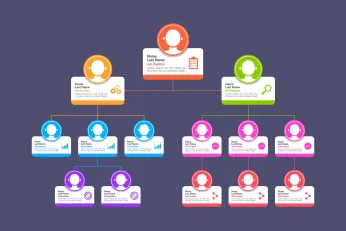On this page
Sales territory mapping is one of the most crucial strategies any sales establishment can adopt. By dividing the entire geographic area into smaller regions, sales representatives can better control how they approach prospective clients and achieve better success in converting them. However, the mapping process must be done carefully and meticulously to enhance sales efficiency and achieve the desired results.
That is why this is a comprehensive guide on mapping your sales territories to get the ideal results. Starting from the design process to how to optimize the territories, we are here to guide you through it all.
What is sales territory mapping?
Sales territory mapping is the process of strategically dividing a company’s sales regions to optimize coverage, maximize revenue, and improve efficiency. It ensures that sales teams focus on the right prospects while minimizing overlap and gaps in customer outreach.
Key components of sales territory mapping:
- Defining sales territories: Assigning geographic, industry-based, or account-specific regions to sales representatives.
- Analyzing market potential: Using data to evaluate customer density, demand, and competition in each territory.
- Balancing workload: Ensuring fair distribution of opportunities to avoid overloading or underutilizing sales reps.
- Optimizing resource allocation: Aligning sales efforts with company goals to maximize revenue and customer satisfaction.
- Leveraging sales mapping tools: Using software to visualize territories, track performance, and adjust strategies as needed.
By implementing sales territory mapping, companies can enhance efficiency, improve customer relationships, and drive higher sales performance.
Why is sales territory mapping important?
Sales territory mapping plays a crucial role in optimizing sales performance, ensuring fair distribution of workload, and maximizing revenue potential. Without a structured approach, sales teams risk inefficiency, missed opportunities, and unbalanced workloads.
Key benefits of sales territory mapping:
- Improves sales efficiency: Helps sales reps focus on the most valuable prospects, reducing wasted effort and increasing productivity.
- Enhances customer coverage: Ensures no potential customer is overlooked while preventing territory overlap among sales reps.
- Balances workloads: Distributes opportunities evenly, preventing burnout and ensuring all sales reps have a fair shot at success.
- Boosts revenue growth: Aligns sales efforts with high-potential areas, leading to better conversions and increased profitability.
- Provides data-driven insights: Helps businesses analyze performance, adjust strategies, and refine territories based on real-time data.
- Optimizes resource allocation: Ensures sales efforts align with business goals, leading to better use of time and budget.
By leveraging sales territory mapping, companies can create a structured, results-driven approach that enhances both efficiency and revenue.
How to create a sales territory map effectively?
In order to create the most effective sales territory map, you can follow a few strategies and tools. These strategies and tools can help you make informed decisions and divide your entire sales territory into regions on insight-based inputs.
1. Evaluate market
Evaluating your market is the first requirement before creating a sales territory map. It would help if you considered your customer demographics, their purchase behaviors, and the market potential of the different regions.
This can help you identify regions with the highest potential, allowing you to assign the most skilled reps and areas with similar customer demographics.
2. Create customer segments
Post your market evaluation, you must categorize your customer base into segments. This segmentation can be done on the basis of demographic, geographic, or industrial factors, such as their location, the industry, as well as the size of the organization.
Adopting such a strategy can help you design bespoke sales approaches specifically tailored to what your audience wants, increasing your chances of a successful deal.
3. Factor as per goals & objectives
Another factor that directly affects the effectiveness of youor sales territory mapping is your company’s goals and objectives. Before creating the mapping, you need to have a clear understanding of its purpose and the end goal. This can help you further ensure you can align your sales territories with these goals, helping you achieve them more effectively.
4. Use SWOT analysis
SWOT analysis of your company can help identify your strengths, weaknesses, opportunities, and threats. This can help you identify your positioning in the market so you can change your approach wherever necessary to get the best results.
Accordingly, you can create sales territory map options that best suit your needs while capitalizing on your areas of strength.
5. Define & assign sales territories
Once you have successfully evaluated all the above factors, you must create feasible segments of the entire territory. Ideally, based on customer metrics and the market potential of each segment, you can assign your talented sales reps to each segment as you see fit. Ensure their areas of specialization align with the territory assigned to them to increase your chances of successful sales deals.
6. Take advantage of sales tools
You can also adopt sales engagement tools and platforms, specifically customer relationship management (CRM) and data visualization tools, to efficiently track your territories. This can help you monitor whether each territory is performing well, and if any changes are needed, these tools can also help you develop appropriate strategies.
Tips for designing a perfect sales territory
Designing the perfect sales territory needs a highly strategic approach to guarantee successful outcomes. You should consider the market factors and customer needs and think of long-term scenarios to ensure you have evergreen sales territories.
Below listed are some tips on how to build a sales territory map by designing the perfect sales territories:
1. Balance business & customer needs
One of the most crucial requirements of designing the perfect sales territory is that your business needs should balance your customers' needs. While you need to consider customer-centric factors, such as their demographics and purchase behaviors, you must also consider how optimized your territories are for maximum sales growth within these customer-specific factors.
2. Think as per market
Another golden rule when designing your sales territories is to think as per the market. You must analyze and consider factors affecting your sales potentials, such as market trends and customer preferences. This will help you figure out which territories have the highest sales potential and allow you to optimize your mapping accordingly.
3. Use adequate tools
Another tip is to use adequate and appropriate sales tools to help you in your mapping efforts. While these can be the data visualization and CRM tools mentioned above, you can also use tools to monitor consumer behavior, track sales figures, and even keep track of the individual performance of your sales representatives.
4. Consider long-term scenarios
Lastly, you should also be mindful of defining your territories based on long-term scenarios and potential situations. It would be best to consider how the market may change in the future, any potential changes to the territory itself, and whether your current territories are optimized adequately enough to stay relevant in the face of such changes.
This will help you design and create sales territory map to ensure your territories continue to yield profitable results regardless of any such changes to the market.
How to optimize sales territory?
After you have designed your sales territories using the tips above, you need to optimize them to ensure maximum sales growth. Such optimization is crucial so you can continue favorable relationships with your clients for the long term. So, here are a few strategies that can help you optimize your sales territories accordingly.
1. Align sales to customer data
The primary stakeholder of your sales efforts is your customer base. This is why one of the most effective strategies to help you optimize your sales territories is aligning your sales efforts to customer data. This means analyzing their behavior and preference, which can help you adjust your mapping and strategies accordingly.
To achieve this, targeted marketing campaigns and customized sales pitches that focus on the specific pain points of your customers can be effective. They can help you ensure that your services are tailored exactly to your customers' needs.
2. Adapt changes at scale
Adaptability is one of the most crucial abilities for any sales establishment in the contemporary context. And to optimize your sales territories as well, you need to adapt successfully to any changes at scale. While these changes can be in the form of changing market scenarios, changing customer preferences, or even changes to the goals and objectives of your own company, adaptation is crucial for successful optimization.
For this purpose, your sales territories need to be designed to comply with any changes quickly and flexibly. From changing the regions your reps are assigned to modifying the territories themselves, flexibility is at the core of optimization.
3. Ensure equitable territories
Equitability is another crucial factor that can help your territory designs become adequately optimized. This means that you must give your sales reps a fair chance to meet their sales targets for the assigned duration, regardless of the potential of the territory they have been assigned to. And to do so, while you should evaluate the potential of each territory, you also need to evaluate the potential of your sales reps against each territory.
Optimize sales territory mapping with Compass
Effective sales territory mapping requires a data-driven approach to ensure sales reps are targeting the right customers while maximizing efficiency. Compass simplifies sales territory planning by providing real-time insights, AI-powered analytics, and automated performance tracking, ensuring territories are balanced, optimized, and aligned with business goals.
✅ Real-time performance tracking: Sales leaders can monitor territory performance in real time, allowing them to adjust strategies, reassign reps, and identify high-potential areas for growth.
✅ Automated incentive management within territories" With Compass, businesses can align incentives with territory performance, ensuring reps are motivated to maximize sales within their assigned areas.
✅ Seamless CRM and sales tool integration: Compass connects with existing CRM systems, ensuring that territory data, sales performance, and customer insights are easily accessible for better decision-making.
With Compass, sales territory mapping becomes a strategic advantage rather than a manual task. Businesses can maximize coverage, improve sales efficiency, and drive higher revenue with well-structured territories.
Conclusion
As crucial as sales territory mapping is, it is also a highly strategic task requiring you to rely on data-based insights and inputs. As a result, you must design it in a way that carefully considers the market and consumer factors influencing your sales efforts.
Through comprehensive monitoring tools, such as CRMs and sales data trackers, you must ensure that your designed territories are flexible enough to stay relevant and effective long-term. So, if you are thinking about "how to build a sales territory map," simply follow the tips to design the perfect maps and optimize them to get the most out of your sales efforts.













